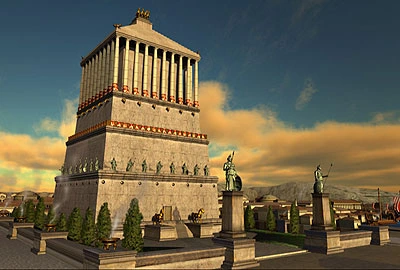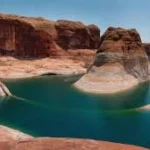
Artemisia built the Mausoleum at Halicarnassus after her husband Mausolus died. For 24 years, Mausolus and Artemisia ruled over Halicarnassus and the surrounding region. When Mausolus died in 353 BC, Artemisia was said to have been so devastated that she commissioned the world’s most talented artists to build the most magnificent tomb in the world. The completed tomb stood 147 feet tall on a hill overlooking Halicarnassus.
The city of Halicarnassus, ruled by Mausolus and Artemisia, is now known as Bodrum, Turkey.
The term mausoleum is derived from the name Mausolus. From that point forward, the term mausoleum was used to refer to above-ground tombs.
Artemisia, Mausolus’ wife, was also his sister. It was common for rulers to marry their sisters back then.
Artemisia commissioned the tomb to be built by famous Greek artists. The tomb’s shape was designed by two Greek architects, Pytheos and Satyros. There were also a number of artists who contributed to the tomb’s cultural influences, which included Greek, Lycian, and Egyptian influences.
Artemisia passed away two years after Mausolus, before the tomb was finished.
Pytheos created the sculpture at the top of the tomb. The carving depicted Mausolus and Artemisia riding in a chariot drawn by four massive horses.
Bryaxis, Scopas of Paros, Timotheus, and Leochares were among the other Greek artists who worked on the Mausoleum of Halicarnassus.
The mausoleum was mostly made of marble. It was encircled by a courtyard.
A staircase was constructed to lead up to the platform where the mausoleum stood. The staircase was flanked by stone lions.
On the walls of the mausoleum, there were scenes of Greek and Amazon warriors and battles in scriptural relief (similar to the images on coins – slightly raised).
The Mausoleum was left untouched when Alexander the Great took over the city in 334 BC.
The Mausoleum was left undamaged when pirates attacked the city in 58 and 62 BC.
Earthquakes in the 13th century toppled the Mausoleum’s columns, destroying the stone chariot.
Crusaders conquered the city in the 13th century. They used many parts of the Mausoleum to build their structures. When you visit Halicarnassus Castle, you can still see pieces of the tomb that were used to strengthen the castle walls.
By 1401 AD, all that remained was the tomb’s base.
The mausoleum’s ruins were discovered in the 1800s by an archaeologist named Charles Newton. He discovered Mausolus and Artemisia statues, as well as a piece of the chariot wheel. They can be seen in the British Museum’s Mausoleum Room.
Crusaders raided the mausoleum around 1522, stealing any treasures or the bodies of Mausolus and Artemisia.
Some believe that Mausolus and Artemisia were cremated and buried in urns in the Halicarnassus Mausoleum. Some speculate that they were buried in coffins. There is no evidence to support either theory.
The Mausoleum at Halicarnassus was chosen as one of the Seven Wonders of the Ancient World by Antipater of Sidon, who was in charge of compiling a list of the Seven Wonders of the Ancient World. His reasoning was that he saw it as an aesthetic triumph.
Frequently Asked Questions about Mausoleum at Halicarnassus:
1. Why was the Mausoleum at Halicarnassus destroyed?
The Mausoleum at Halicarnassus was destroyed primarily due to a series of earthquakes that occurred in the region. The most significant earthquakes happened in the 12th and 15th centuries, which caused considerable damage to the structure. Additionally, after the mausoleum fell into ruins, its stones were repurposed for building materials in other constructions, including the Castle of St. Peter, which was built by the Knights of St. John in the 15th century. This further contributed to the loss of the mausoleum’s architectural integrity.
2. Does the Mausoleum at Halicarnassus still exist today?
The Mausoleum at Halicarnassus no longer exists in its original form. It was one of the Seven Wonders of the Ancient World, but now only the foundations and some remnants of the structure can be seen at the archaeological site in Bodrum, Turkey. The site is marked by ruins that give an idea of its grandeur, but the complete structure has not survived.
3. Is the Mausoleum at Halicarnassus worth visiting?
Visiting the site of the Mausoleum at Halicarnassus can be worthwhile for those interested in history, archaeology, and ancient architecture. The site offers insights into Hellenistic architecture and the cultural significance of mausoleums in the ancient world. Additionally, Bodrum itself is a beautiful coastal city with other attractions, including the Bodrum Castle and the Museum of Underwater Archaeology. For history enthusiasts, the remnants of the mausoleum provide a tangible connection to one of the wonders of antiquity.
4. Why was the Mausoleum built?
The Mausoleum at Halicarnassus was built as a tomb for Mausolus, a Persian satrap of Caria, and his wife, Artemisia II. It was constructed around 350 BCE and was intended to honor Mausolus and display the wealth and power of the Carian kingdom. The structure was designed by the Greek architects Pythius and Satyrus and was adorned with sculptures and reliefs that represented various mythological and historical themes. The mausoleum was a symbol of Mausolus’s status and served as a lasting monument to his legacy.










I stumbled upon this blog post while searching for information on the topic, and I have to say, I was blown away by the quality of the writing. The author has a real talent for making complex ideas accessible to a wider audience. I found myself getting drawn into the post and reading through it in one sitting. The resources mentioned in the post were also a great addition – it’s clear that the author has put a lot of thought and effort into making this post as helpful as possible. Thank you for sharing your insights with us!